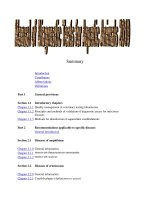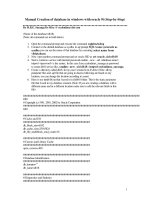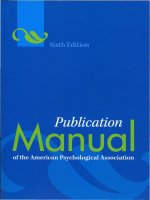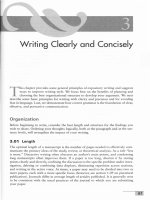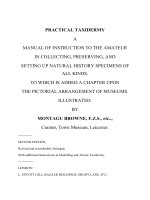Manual of Radiotelephony
Bạn đang xem bản rút gọn của tài liệu. Xem và tải ngay bản đầy đủ của tài liệu tại đây (2.35 MB, 102 trang )
Doc 9432
AN/925
Manual of
Radiotelephony
Approved by the Secretary General
and published under his authority
Fourth Edition — 2007
International Civil Aviation Organization
Published in separate English, French, Russian and Spanish editions by the International Civil Aviation Organization. All
correspondence, except orders and subscriptions, should be addressed to the Secretary General.
Orders should be sent to one of the following addresses, together with the appropriate remittance in U.S. dollars or in the currency of the
country in which the order is placed. Customers are encouraged to use credit cards (MasterCard, Visa or American Express) to avoid
delivery delays. Information on payment by credit card and by other methods is available in the Ordering Information Section of the
Catalogue of ICAO Publications and Audio-visual Training Aids.
International Civil Aviation Organization. Attention: Document Sales Unit, 999 University Street, Montréal, Quebec, Canada H3C 5H7
Telephone: +1 514-954-8022; Facsimile: +1 514-954-6769; Sitatex: YULCAYA; E-mail: ;
World Wide Web:
Cameroon. KnowHow, 1, Rue de la Chambre de Commerce-Bonanjo, B.P. 4676, Douala / Telephone: +237 343 98 42; Facsimile: +237 343 89 25;
E-mail:
China. Glory Master International Limited, Room 434B, Hongshen Trade Centre, 428 Dong Fang Road, Pudong, Shanghai 200120
Telephone: +86 137 0177 4638; Facsimile: +86 21 5888 1629; E-mail:
Egypt. ICAO Regional Director, Middle East Office, Egyptian Civil Aviation Complex, Cairo Airport Road, Heliopolis, Cairo 11776
Telephone: +20 2 267 4840; Facsimile: +20 2 267 4843; Sitatex: CAICAYA; E-mail:
Germany. UNO-Verlag GmbH, August-Bebel-Allee 6, 53175 Bonn / Telephone: +49 0 228-94 90 2-0; Facsimile: +49 0 228-94 90 2-22;
E-mail: ; World Wide Web:
India. Oxford Book and Stationery Co., 57, Medha Apartments, Mayur Vihar, Phase-1, New Delhi – 110 091
Telephone: +91 11 65659897; Facsimile: +91 11 22743532
India. Sterling Book House – SBH, 181, Dr. D. N. Road, Fort, Bombay 400001
Telephone: +91 22 2261 2521, 2265 9599; Facsimile: +91 22 2262 3551; E-mail:
India. The English Book Store, 17-L Connaught Circus, New Delhi 110001
Telephone: +91 11 2341-7936, 2341-7126; Facsimile: +91 11 2341-7731; E-mail:
Japan. Japan Civil Aviation Promotion Foundation, 15-12, 1-chome, Toranomon, Minato-Ku, Tokyo
Telephone: +81 3 3503-2686; Facsimile: +81 3 3503-2689
Kenya. ICAO Regional Director, Eastern and Southern African Office, United Nations Accommodation, P.O. Box 46294, Nairobi
Telephone: +254 20 7622 395; Facsimile: +254 20 7623 028; Sitatex: NBOCAYA; E-mail:
Mexico. Director Regional de la OACI, Oficina Norteamérica, Centroamérica y Caribe, Av. Presidente Masaryk No. 29, 3er Piso,
Col. Chapultepec Morales, C.P. 11570, México D.F. / Teléfono: +52 55 52 50 32 11; Facsímile: +52 55 52 03 27 57;
Correo-e:
Nigeria. Landover Company, P.O. Box 3165, Ikeja, Lagos
Telephone: +234 1 4979780; Facsimile: +234 1 4979788; Sitatex: LOSLORK; E-mail:
Peru. Director Regional de la OACI, Oficina Sudamérica, Av. Víctor Andrés Belaúnde No. 147, San Isidro, Lima (Centro Empresarial Real, Vía
Principal No. 102, Edificio Real 4, Floor 4)
Teléfono: +51 1 611 8686; Facsímile: +51 1 611 8689; Correo-e:
Russian Federation. Aviaizdat, 48, Ivan Franko Street, Moscow 121351 / Telephone: +7 095 417-0405; Facsimile: +7 095 417-0254
Senegal. Directeur régional de l’OACI, Bureau Afrique occidentale et centrale, Boîte postale 2356, Dakar
Téléphone: +221 839 9393; Fax: +221 823 6926; Sitatex: DKRCAYA; Courriel:
Slovakia. Air Traffic Services of the Slovak Republic, Letové prevádzkové služby Slovenskej Republiky, State Enterprise,
Letisko M.R. Štefánika, 823 07 Bratislava 21 / Telephone: +421 2 4857 1111; Facsimile: +421 2 4857 2105; E-mail:
South Africa. Avex Air Training (Pty) Ltd., Private Bag X102, Halfway House, 1685, Johannesburg
Telephone: +27 11 315-0003/4; Facsimile: +27 11 805-3649; E-mail:
Spain. A.E.N.A. — Aeropuertos Españoles y Navegación Aérea, Calle Juan Ignacio Luca de Tena, 14, Planta Tercera, Despacho 3. 11,
28027 Madrid / Teléfono: +34 91 321-3148; Facsímile: +34 91 321-3157; Correo-e:
Switzerland. Adeco-Editions van Diermen, Attn: Mr. Martin Richard Van Diermen, Chemin du Lacuez 41, CH-1807 Blonay
Telephone: +41 021 943 2673; Facsimile: +41 021 943 3605; E-mail:
Thailand. ICAO Regional Director, Asia and Pacific Office, P.O. Box 11, Samyaek Ladprao, Bangkok 10901
Telephone: +66 2 537 8189; Facsimile: +66 2 537 8199; Sitatex: BKKCAYA; E-mail:
United Kingdom. Airplan Flight Equipment Ltd. (AFE), 1a Ringway Trading Estate, Shadowmoss Road, Manchester M22 5LH
Telephone: +44 161 499 0023; Facsimile: +44 161 499 0298; E-mail: ; World Wide Web:
5/07
Catalogue of ICAO Publications
and Audio-visual Training Aids
Issued annually, the Catalogue lists all publications and audio-visual training aids
currently available. Supplements to the Catalogue announce new publications and
audio-visual training aids, amendments, supplements, reprints, etc.
Available free from the Document Sales Unit, ICAO.
Doc 9432
AN/925
Manual of
Radiotelephony
Approved by the Secretary General
and published under his authority
Fourth Edition — 2007
International Civil Aviation Organization
AMENDMENTS
The issue of amendments is announced regularly in the ICAO Journal and in the
supplements to the Catalogue of ICAO Publications and Audio-visual Training
Aids, which holders of this publication should consult. The space below is provided
to keep a record of such amendments.
RECORD OF AMENDMENTS AND CORRIGENDA
AMENDMENTS
No.
Date
CORRIGENDA
Entered by
No.
(ii)
Date
Entered by
FOREWORD
ICAO phraseologies are contained in procedures found in Annex 10 — Aeronautical Telecommunications,
Volume II — Communication Procedures including those with PANS status and in the Procedures for Air
Navigation Services — Air Traffic Management (PANS-ATM, Doc 4444). The purpose of this manual is to
provide examples of the radiotelephony phraseology found in those two documents. While the procedures and
phraseology specifically reflect the situation in an environment where very high frequency (VHF) is in use, they
are equally applicable in those areas where high frequency (HF) is used.
ICAO phraseologies are developed to provide efficient, clear, concise, and unambiguous communications,
and constant attention should be given to the correct use of ICAO phraseologies in all instances in which they
are applicable. However, it is not possible to provide phraseologies to cover every conceivable situation which
may arise, and the examples contained in this manual are not exhaustive, but merely representative of
radiotelephony phraseology in common use. Users may find it necessary to supplement phraseologies with
the use of “plain” language. When it is necessary to use plain language, it should be used according to the
same principles that govern the development of phraseologies in that communications should be clear,
concise, and unambiguous. Sufficient proficiency in the language being used is also required. (ICAO language
proficiency requirements are found in ICAO Annex 10, Volume II and Annex 1 — Personnel Licensing.) In
addition to correct use of phraseologies and adequate language proficiency, it is also important to keep in mind
that the language being used in radiotelephony is often not the first language of the receiver or originator of a
transmission. An awareness of the special difficulties faced by second-language speakers contributes to safer
communications. Transmissions should be slow and clear. Direct statements which avoid idiomatic
expressions are easier to understand than indirect statements or colloquialisms or slang.
Furthermore, certain States may specify in their aeronautical information publication (AIP) particular
requirements on first contact when entering their airspace or prior to leaving their airspace. Pilots should,
therefore, ensure that they are aware of such procedures by referring to the relevant instructions (e.g. AIP and
NOTAM) before undertaking international flights. Examples of phraseology of this type are beyond the scope
of this manual.
___________________
(iii)
TABLE OF CONTENTS
Page
CHAPTER 1 — Glossary ......................................................................................................................
1.1
1.2
1.3
1-1
Definitions of principal terms used in this manual...................................................................
Commonly used abbreviations................................................................................................
Explanation of scenario...........................................................................................................
1-1
1-4
1-6
CHAPTER 2 — General operating procedures..................................................................................
2-1
2.1
2.2
2.3
2.4
2.5
2.6
2.7
Introduction .............................................................................................................................
Transmitting technique............................................................................................................
Transmission of letters ............................................................................................................
Transmission of numbers........................................................................................................
Transmission of time ...............................................................................................................
Standard words and phrases ..................................................................................................
Call signs.................................................................................................................................
2.7.1 Call signs for aeronautical stations ..............................................................................
2.7.2 Aircraft call signs ..........................................................................................................
Communications .....................................................................................................................
2.8.1 Establishment and continuation of communications ....................................................
2.8.2 Transfer of communications.........................................................................................
2.8.3 Issue of clearance and read-back requirements..........................................................
2.8.4 Test procedures ...........................................................................................................
2-1
2-1
2-2
2-3
2-6
2-6
2-8
2-8
2-9
2-10
2-10
2-12
2-13
2-15
CHAPTER 3 — General phraseology .................................................................................................
3-1
2.8
3.1
3.2
Introduction .............................................................................................................................
An explanation of the role of phraseologies and plain language in radiotelephony
communications ......................................................................................................................
Level instructions ....................................................................................................................
Position reporting ....................................................................................................................
Flight plans..............................................................................................................................
3-1
3-2
3-4
3-5
CHAPTER 4 — Aerodrome control: aircraft ......................................................................................
4-1
3.3
3.4
3.5
4.1
4.2
4.3
4.4
4.5
4.6
4.7
4.8
4.9
4.10
Introduction .............................................................................................................................
Departure information and engine starting procedures ..........................................................
Push-back ...............................................................................................................................
Taxi instructions ......................................................................................................................
Take-off procedures ................................................................................................................
Aerodrome traffic circuit ..........................................................................................................
Final approach and landing.....................................................................................................
Go around ...............................................................................................................................
After landing ............................................................................................................................
Essential aerodrome information ............................................................................................
(v)
3-1
4-1
4-1
4-2
4-3
4-6
4-9
4-13
4-14
4-15
4-16
(vi)
Manual of Radiotelephony
Page
CHAPTER 5 — Aerodrome control: vehicles ....................................................................................
5.1
5.2
5.3
5.4
5-1
Introduction .............................................................................................................................
Movement instructions ............................................................................................................
Crossing runways....................................................................................................................
Vehicles towing aircraft ...........................................................................................................
5-1
5-1
5-3
5-4
CHAPTER 6 — General ATS surveillance service phraseology......................................................
6-1
6.1
6.2
6.3
6.4
6.5
6.6
6.7
Introduction .............................................................................................................................
Identification and vectoring .....................................................................................................
Vectoring .................................................................................................................................
Traffic information and avoiding action ...................................................................................
Secondary surveillance radar .................................................................................................
Radar assistance to aircraft with radiocommunications failure...............................................
Alerting phraseologies.............................................................................................................
6-1
6-1
6-2
6-4
6-5
6-6
6-7
CHAPTER 7 — Approach control .......................................................................................................
7-1
7.1
7.2
7.3
7.4
7.5
7.6
7.7
IFR departures ........................................................................................................................
VFR departures.......................................................................................................................
IFR arrivals..............................................................................................................................
VFR arrivals ............................................................................................................................
Vectors to final approach ........................................................................................................
Surveillance radar approach ...................................................................................................
Precision radar approach ........................................................................................................
7-1
7-1
7-2
7-6
7-7
7-8
7-12
CHAPTER 8 — Area control ................................................................................................................
8-1
8.1
8.2
8.3
8.4
8.5
8.6
8.7
8.8
8.9
8.10
Area control units ....................................................................................................................
Position information.................................................................................................................
Level information.....................................................................................................................
Flights joining airways .............................................................................................................
Flights leaving airways ............................................................................................................
Flights crossing airways ..........................................................................................................
Flights holding en route...........................................................................................................
ATS Surveillance.....................................................................................................................
Automatic Dependent Surveillance (ADS) ..............................................................................
Oceanic control .......................................................................................................................
8-1
8-2
8-3
8-4
8-6
8-6
8-6
8-7
8-8
8-8
CHAPTER 9 — Distress and urgency procedures and communications failure procedures ......
9-1
9.1
9.2
9.3
9.4
9.5
Introduction .............................................................................................................................
Distress messages..................................................................................................................
9.2.1 Aircraft in distress.........................................................................................................
9.2.2 Imposition of silence.....................................................................................................
9.2.3 Termination of distress and silence..............................................................................
Urgency messages .................................................................................................................
Emergency descent ................................................................................................................
Aircraft communications failure...............................................................................................
9-1
9-2
9-2
9-3
9-3
9-4
9-5
9-6
Table of Contents
(vii)
Page
CHAPTER 10 — Transmission of meteorological and other aerodrome information ..................
10-1
10.1 Introduction .............................................................................................................................
10.2 Runway Visual Range (RVR)..................................................................................................
10.3 Runway surface conditions .....................................................................................................
10-1
10-1
10-2
CHAPTER 11 — Miscellaneous flight handling.................................................................................
11-1
11.1
11.2
11.3
11.4
11.5
11.6
Selective Calling (SELCAL) ....................................................................................................
Fuel dumping ..........................................................................................................................
Wake turbulence .....................................................................................................................
Wind shear ..............................................................................................................................
Direction finding ......................................................................................................................
ACAS manoeuvres..................................................................................................................
___________________
11-1
11-2
11-2
11-3
11-3
11-4
Chapter 1
GLOSSARY
1.1
DEFINITIONS OF PRINCIPAL TERMS USED IN THIS MANUAL
Note.— Other definitions will be found in the appropriate ICAO documents.
Aerodrome control service. Air traffic control service for aerodrome traffic.
Aerodrome traffic. All traffic on the manoeuvring area of an aerodrome and all aircraft flying in the vicinity of an
aerodrome.
Note.— An aircraft is in the vicinity of an aerodrome when it is in, entering or leaving an aerodrome traffic
circuit.
Aerodrome traffic circuit. The specified path to be flown by aircraft operating in the vicinity of an aerodrome.
Aeronautical mobile service (RR S1.32). A mobile service between aeronautical stations and aircraft stations,
or between aircraft stations, in which survival craft stations may participate; emergency position-indicating
radiobeacon stations may also participate in this service on designated distress and emergency
frequencies.
Aeronautical station (RR S1.81). A land station in the aeronautical mobile service. In certain instances, an
aeronautical station may be located, for example, on board ship or on a platform at sea.
Air-ground communication. Two-way communication between aircraft and stations or locations on the surface
of the earth.
Air traffic. All aircraft in flight or operating on the manoeuvring area of an aerodrome.
Air traffic control clearance. Authorization for an aircraft to proceed under conditions specified by an air traffic
control unit.
Note 1.— For convenience, the term “air traffic control clearance” is frequently abbreviated to “clearance”
when used in appropriate contexts.
Note 2.— The abbreviated term “clearance” may be prefixed by the words “taxi”, “take-off”, “departure”,
“en route”, “approach” or “landing” to indicate the particular portion of flight to which the air traffic control
clearance relates.
Air traffic service (ATS). A generic term meaning variously, flight information service, alerting service, air traffic
advisory service, air traffic control service (area control service, approach control service or aerodrome
control service).
Air traffic services unit. A generic term meaning variously, air traffic control unit, flight information centre or air
traffic services reporting office.
1-1
1-2
Manual of Radiotelephony
Airway. A control area or portion thereof established in the form of a corridor.
Altitude. The vertical distance of a level, a point or an object considered as a point, measured from mean sea
level (MSL).
Approach control service. Air traffic control service for arriving or departing controlled flights.
Apron. A defined area, on a land aerodrome, intended to accommodate aircraft for purposes of loading or
unloading passengers, mail or cargo, fuelling, parking or maintenance.
Area control centre (ACC). A unit established to provide air traffic control service to controlled flights in control
areas under its jurisdiction.
Automatic terminal information service (ATIS). The automatic provision of current, routine information to
arriving and departing aircraft throughout 24 hours or a specified portion thereof:
Data link-automatic terminal information service (D-ATIS). The provision of ATIS via data link.
Voice-automatic terminal information service (Voice-ATIS). The provision of ATIS by means of continuous
and repetitive voice broadcasts.
Blind transmission. A transmission from one station to another station in circumstances where two-way
communication cannot be established but where it is believed that the called station is able to receive the
transmission.
Broadcast. A transmission of information relating to air navigation that is not addressed to a specific station or
stations.
Clearance limit. The point to which an aircraft is granted an air traffic control clearance.
Controlled airspace. An airspace of defined dimensions within which air traffic control service is provided in
accordance with the airspace classification.
Note.— Controlled airspace is a generic term which covers ATS airspace Classes A, B, C, D and E as
described in Annex 11.
Control zone. A controlled airspace extending upwards from the surface of the earth to a specified upper limit.
Expected approach time. The time at which ATC expects that an arriving aircraft, following a delay, will leave
the holding fix to complete its approach for a landing.
Note.— The actual time of leaving the holding fix will depend upon the approach clearance.
Flight information centre. A unit established to provide flight information service and alerting service.
Flight plan. Specified information provided to air traffic services units, relative to an intended flight or portion of
a flight of an aircraft.
Note.— Specifications for flight plans are contained in Annex 2. A Model Flight Plan Form is contained in
Appendix 2 to the PANS-ATM.
Heading. The direction in which the longitudinal axis of an aircraft is pointed, usually expressed in degrees
from North (true, magnetic, compass or grid).
Chapter 1.
Glossary
1-3
Holding fix. A geographical location that serves as a reference for a holding procedure.
Holding procedure. A predetermined manoeuvre which keeps an aircraft within a specified airspace while
awaiting further clearance.
IFR flight. A flight conducted in accordance with the instrument flight rules.
Instrument meteorological conditions (IMC). Meteorological conditions expressed in terms of visibility,
distance from cloud, and ceiling, less than the minima specified for visual meteorological conditions.
Level. A generic term relating to the vertical position of an aircraft in flight and meaning variously, height,
altitude or flight level.
Manoeuvring area. That part of an aerodrome to be used for the take-off, landing and taxiing of aircraft,
excluding aprons.
Missed approach procedure. The procedure to be followed if the approach cannot be continued.
Movement area. That part of an aerodrome to be used for the take-off, landing and taxiing of aircraft,
consisting of the manoeuvring area and the apron(s).
Radar approach. An approach in which the final approach phase is executed under the direction of a radar
controller.
Radar identification. The situation which exists when the radar position of a particular aircraft is seen on a
radar display and positively identified by the air traffic controller.
Reporting point. A specified geographical location in relation to which the position of an aircraft can be
reported.
Runway visual range (RVR). The range over which the pilot of an aircraft on the centre line of a runway can
see the runway surface markings or the lights delineating the runway or identifying its centre line.
Touchdown. The point where the nominal glide path intercepts the runway.
Note.— “Touchdown” as defined above is only a datum and is not necessarily the actual point at which the
aircraft will touch the runway.
Track. The projection on the earth’s surface of the path of an aircraft, the direction of which path at any point is
usually expressed in degrees from North (true, magnetic or grid).
Vectoring. Provision of navigational guidance to aircraft in the form of specific headings, based on the use of
radar.
VFR flight. A flight conducted in accordance with the visual flight rules.
Visual approach. An approach by an IFR flight when either part or all of an instrument approach procedure is
not completed and the approach is executed in visual reference to terrain.
Visual meteorological conditions. Meteorological conditions expressed in terms of visibility, distance from
cloud, and ceiling, equal to or better than specified minima.
Note.— The specified minima are contained in Annex 2.
1-4
Manual of Radiotelephony
1.2
COMMONLY USED ABBREVIATIONS
Note.— The abbreviations listed below are normally spoken using the constituent letters, rather than the
spelling alphabet, except that those indicated by an asterisk are normally spoken as complete words.
ACC
Area control centre or area control
ADF
Automatic direction-finding equipment
AFIS
Aerodrome flight information service
AGL
Above ground level
AIP
Aeronautical information publication
AIRAC*
Aeronautical information regulation and control
AIS
Aeronautical information services
AMSL
Above mean sea level
ATC
Air traffic control (in general)
ATD
Actual time of departure
ATIS*
Automatic terminal information service
ATS
Air traffic services
ATZ
Aerodrome traffic zone
CAVOK*
Visibility, cloud and present weather better than prescribed values or conditions
CTR
Control zone
DME
Distance measuring equipment
EET
Estimated elapsed time
ETA
Estimated time of arrival or estimating arrival
ETD
Estimated time of departure or estimating departure
FIC
Flight information centre
FIR
Flight information region
FIS
Flight information service
GCA
Ground controlled approach system or ground controlled approach
H24
Continuous day and night service
Chapter 1.
Glossary
1-5
HF
High frequency (3 to 30 MHz)
IFR
Instrument flight rules
ILS
Instrument landing system
IMC
Instrument meteorological conditions
INS
Inertial navigation system
LORAN*
Long range air navigation system
MET*
Meteorological or meteorology
MLS
Microwave landing system
MNPS
Minimum navigation performance specifications
NDB
Non-directional radio beacon
NIL*
None or I have nothing to send you
NOTAM*
A notice distributed by means of telecommunication containing information concerning the
establishment, condition or change in any aeronautical facility, service, procedure or
hazard, the timely knowledge of which is essential to personnel concerned with flight
operations
PAPI*
Precision approach path indicator
QFE
Atmospheric pressure at aerodrome elevation (or at runway threshold)
QNH
Altimeter sub-scale setting to obtain elevation when on the ground
RCC
Rescue coordination centre
RNAV*
Area navigation
RVR
Runway visual range
SELCAL*
A system which permits the selective calling of individual aircraft over radiotelephone
channels linking a ground station with the aircraft
SID*
Standard instrument departure
SIGMET*
Information issued by a meteorological watch office concerning the occurrence or
expected occurrence of specified en-route weather phenomena which may affect the
safety of aircraft operations
SNOWTAM*
A special series NOTAM notifying the presence or removal of hazardous conditions due to
snow, ice, slush or standing water associated with snow, slush and ice on the movement
area, by means of a specific format
SSR
Secondary surveillance radar
1-6
Manual of Radiotelephony
SST
Supersonic transport
STAR*
Standard (instrument) arrival
TACAN*
UHF tactical air navigation aid
TAF*
Aerodrome forecast
TMA
Terminal control area
UHF
Ultra-high frequency (300 to 3 000 MHz)
UIR
Upper flight information region
UTA
Upper control area
UTC
Coordinated universal time
VASIS*
Visual approach slope indicator system
VDF
Very high frequency direction-finding station
VFR
Visual flight rules
VHF
Very high frequency (30 to 300 MHz)
VIP
Very important person
VMC
Visual meteorological conditions
VOLMET*
Meteorological information for aircraft in flight
VOR
VHF omnidirectional radio range
VORTAC*
VOR and TACAN combination
1.3
EXPLANATION OF SCENARIO
1.3.1 In order for the reader to understand the context in which specific phrases are used, most of the
examples of phraseology in this manual relate to typical situations, using fictitious call signs and locations. Any
similarity with actual aircraft and ground station call signs is coincidental.
1.3.2 In the examples, the aircraft or ground station transmitting is shown by the symbol in Table 1. The
station initiating the exchange of messages is in bold type. To facilitate following the sequence of the
messages each subsequent message commences below the previous one throughout the exchange.
1.3.3 The scenario for the phraseologies throughout this manual is based on an imaginary country using
the non-SI alternative units of measurement. Users of the manual in States which have adopted the SI units of
measurement should substitute the correct units as appropriate.
Chapter 1.
Glossary
1-7
Table 1
Call sign
Symbol
Meaning
G-ABCD
G-CD
Aircraft operating in accordance with VFR
G-CDAB
G-AB
General aviation aircraft operating in accordance with IFR
FASTAIR 345
Airline aircraft operating in accordance with IFR
TOWER
GROUND
Aerodrome control service
Surface movement control
APPROACH
Approach control service
CONTROL
Area control service
INFORMATION
RADIO
Flight information service
Aeronautical station
RADAR
Radar
1-8
Call sign
Manual of Radiotelephony
Symbol
Meaning
TRUCKER 5
WORKER 21
Vehicles
TOW 5
Aircraft under tow
Ground crew
APRON
Apron management service
G-HELI
Helicopter
___________________
Chapter 2
GENERAL OPERATING PROCEDURES
2.1
INTRODUCTION
Radiotelephony (RTF) provides the means by which pilots and ground personnel communicate with each
other. The information and instructions transmitted are of vital importance in the safe and expeditious
operation of aircraft. Incidents and accidents have occurred in which a contributing factor has been the use of
non-standard procedures and phraseology. The importance of using correct and precise standardized
phraseology cannot be overemphasized.
2.2
TRANSMITTING TECHNIQUE
2.2.1 The following transmitting techniques will assist in ensuring that transmitted speech is clear and
satisfactorily received:
a) before transmitting, listen out on the frequency to be used to ensure that there will be no interference
with a transmission from another station;
b) be familiar with good microphone operating techniques;
c) use a normal conversational tone, and speak clearly and distinctly;
d) maintain an even rate of speech not exceeding 100 words per minute. When it is known that elements
of the message will be written down by the recipient, speak at a slightly slower rate;
e) maintain the speaking volume at a constant level;
f)
a slight pause before and after numbers will assist in making them easier to understand;
g) avoid using hesitation sounds such as “er”;
h) be familiar with the microphone operating techniques, particularly in relation to the maintenance of a
constant distance from the microphone if a modulator with a constant level is not used;
i)
suspend speech temporarily if it becomes necessary to turn the head away from the microphone;
j) depress the transmit switch fully before speaking and do not release it until the message is completed.
This will ensure that the entire message is transmitted;
k) the transmission of long messages should be interrupted momentarily from time to time to permit the
transmitting operator to confirm that the frequency in use is clear and, if necessary, to permit the
receiving operator to request repetition of parts not received.
2-1
2-2
Manual of Radiotelephony
2.2.2 An irritating and potentially dangerous situation in radiotelephony is a “stuck” microphone button.
Operators should always ensure that the button is released after a transmission and the microphone placed in
an appropriate place ensuring that it will not inadvertently be switched on.
2.3
TRANSMISSION OF LETTERS
2.3.1 To expedite communications, the use of phonetic spelling should be dispensed with if there is no
risk of this affecting correct reception and intelligibility of the message.
2.3.2 With the exception of the telephony designator and the type of aircraft, each letter in the aircraft
call sign shall be spoken separately using the phonetic spelling.
2.3.3
The words in the table below shall be used when using the phonetic spelling.
Note.— Syllables to be emphasized are underlined.
Letter
Word
Pronunciation
A
Alpha
AL FAH
B
Bravo
BRAH VOH
C
Charlie
CHAR LEE or
SHAR LEE
D
Delta
DELL TAH
E
Echo
ECK OH
F
Foxtrot
FOKS TROT
G
Golf
GOLF
H
Hotel
HO TELL
I
India
IN DEE AH
J
Juliett
JEW LEE ETT
K
Kilo
KEY LOH
L
Lima
LEE MAH
M
Mike
MIKE
N
November
NO VEM BER
O
Oscar
OSS CAH
P
Papa
PAH PAH
Q
Quebec
KEH BECK
R
Romeo
ROW ME OH
S
Sierra
SEE AIR RAH
T
Tango
TANG GO
U
Uniform
YOU NEE FORM or
OO NEE FORM
Chapter 2.
General operating procedures
2-3
Letter
Word
Pronunciation
V
Victor
VIK TAH
W
Whiskey
WISS KEY
X
X-ray
ECKS RAY
Y
Yankee
YANG KEY
Z
Zulu
ZOO LOO
2.4
TRANSMISSION OF NUMBERS
2.4.1 When the language used for communication is English, numbers shall be transmitted using the
following pronunciation:
Note.— The syllables printed in capital letters are to be stressed; for example, the two syllables in ZE-RO
are given equal emphasis, whereas the first syllable of FOW-er is given primary emphasis.
2.4.2
Numeral or numeral element
Pronunciation
0
ZE-RO
1
WUN
2
TOO
3
TREE
4
FOW-er
5
FIFE
6
SIX
7
SEV-en
8
AIT
9
NIN-er
Decimal
DAY-SEE-MAL
Hundred
HUN-dred
Thousand
TOU-SAND
All numbers, except as specified in 2.4.3, shall be transmitted by pronouncing each digit separately.
aircraft call signs
transmitted as
CCA 238
OAL 242
Air China two three eight
Olympic two four two
flight levels
transmitted as
FL 180
FL 200
flight level one eight zero
flight level two zero zero
2-4
Manual of Radiotelephony
headings
transmitted as
100 degrees
080 degrees
heading one zero zero
heading zero eight zero
wind direction and speed
transmitted as
200 degrees 25 knots
wind two zero zero degrees
two five knots
160 degrees 18 knots
gusting 30 knots
wind one six zero degrees one
eight knots gusting three zero knots
transponder codes
transmitted as
2 400
4 203
squawk two four zero zero
squawk four two zero three
runway
transmitted as
27
30
runway two seven
runway three zero
altimeter setting
transmitted as
1 010
1 000
QNH one zero one zero
QNH one zero zero zero
2.4.3 All numbers used in the transmission of altitude, cloud height, visibility and runway visual range
(RVR) information, which contain whole hundreds and whole thousands, shall be transmitted by pronouncing
each digit in the number of hundreds or thousands followed by the word HUNDRED or THOUSAND as
appropriate. Combinations of thousands and whole hundreds shall be transmitted by pronouncing each digit in
the number of thousands followed by the word THOUSAND followed by the number of hundreds followed by
the word HUNDRED.
altitude
transmitted as
800
3 400
12 000
eight hundred
three thousand four hundred
one two thousand
cloud height
transmitted as
2 200
4 300
two thousand two hundred
four thousand three hundred
visibility
transmitted as
1 000
700
visibility one thousand
visibility seven hundred
runway visual range
transmitted as
600
1 700
RVR six hundred
RVR one thousand seven hundred
2.4.4 Except as specified in 2.4.5 all six digits of the numerical designator should be used to identify the
transmitting channel in VHF radiotelephony communications, except in the case of both the fifth and sixth
digits being zeros, in which case only the first four digits should be used.
Chapter 2.
General operating procedures
2-5
Note 1.— The following examples illustrate the application of the procedure in 2.4.4:
Channel
Transmitted as
118.000
ONE ONE EIGHT DECIMAL ZERO
118.005
ONE ONE EIGHT DECIMAL ZERO ZERO FIVE
118.010
ONE ONE EIGHT DECIMAL ZERO ONE ZERO
118.025
ONE ONE EIGHT DECIMAL ZERO TWO FIVE
118.050
ONE ONE EIGHT DECIMAL ZERO FIVE ZERO
118.100
ONE ONE EIGHT DECIMAL ONE
Note 2.— Caution must be exercised with respect to the indication of transmitting channels in VHF
radiotelephony communications when all six digits of the numerical designator are used in airspace where
communication channels are separated by 25 kHz, because on aircraft installations with a channel separation
capability of 25 kHz or more, it is only possible to select the first five digits of the numerical designator on the
radio management panel.
Note 3.— The numerical designator corresponds to the channel identification in Annex 10, Volume V,
Table 4-1 (bis).
2.4.5 In airspace where all VHF voice communications channels are separated by 25 kHz or more and the
use of six digits as in 2.4.4 is not substantiated by the operational requirement determined by the appropriate
authorities, the first five digits of the numerical designator should be used, except in the case of both the fifth
and sixth digits being zeros, in which case only the first four digits should be used.
Note 1.— The following examples illustrate the application of the procedure in 2.4.5 and the associated
settings of the aircraft radio management panel for communication equipment with channel separation
capabilities of 25 kHz and 8.33/25 kHz:
Radio management panel setting for
communication equipment with
Channel
Transmitted as
25 kHz
(5 digits)
8.33/
25 kHz
(6 digits)
118.000
ONE ONE EIGHT DECIMAL ZERO
118.00
118.000
118.025
ONE ONE EIGHT DECIMAL ZERO TWO
118.02
118.025
118.050
ONE ONE EIGHT DECIMAL ZERO FIVE
118.05
118.050
118.075
ONE ONE EIGHT DECIMAL ZERO SEVEN
118.07
118.075
118.100
ONE ONE EIGHT DECIMAL ONE
118.10
118.100
Note 2.— Caution must be exercised with respect to the indication of transmitting channels in VHF
radiotelephony communications when five digits of the numerical designator are used in airspace where
aircraft are also operated with channel separation capabilities of 8.33/25 kHz. On aircraft installations with a
channel separation capability of 8.33 kHz and more, it is possible to select six digits on the radio management
panel. It should therefore be ensured that the fifth and sixth digits are set to 25 kHz channels (see Note 1).
Note 3.— The numerical designator corresponds to the channel identification in Annex 10, Volume V,
Table 4-1 (bis).
2-6
Manual of Radiotelephony
2.5
TRANSMISSION OF TIME
2.5.1 When transmitting time, only the minutes of the hour should normally be required. Each digit should
be pronounced separately. However, the hour should be included when any possibility of confusion is likely to
result.
Note.— The following example illustrates the application of this procedure:
Time
Statement
0920 (9:20 A.M.)
TOO ZE-RO or ZE-RO NIN-er TOO ZE-RO
1643 (4:43 P.M.)
FOW-er TREE or WUN SIX FOW-er TREE
2.5.2 Pilots may check the time with the appropriate ATS unit. Time checks shall be given to the nearest
half minute.
FASTAIR 345 REQUEST TIME
CHECK
FASTAIR 345 TIME 0611
or
FASTAIR 345 TIME 0715 AND
A HALF
2.6
STANDARD WORDS AND PHRASES
The following words and phrases shall be used in radiotelephony communications as appropriate and shall
have the meaning given below.
Word/Phrase
Meaning
ACKNOWLEDGE
“Let me know that you have received and understood this message.”
AFFIRM
“Yes.”
APPROVED
“Permission for proposed action granted.”
BREAK
“I hereby indicate the separation between portions of the message.”
Note. — To be used where there is no clear distinction between the text and other
portions of the message.
BREAK BREAK
“I hereby indicate the separation between messages transmitted to different aircraft in a
very busy environment.”
CANCEL
“Annul the previously transmitted clearance.”
CHECK
“Examine a system or procedure.”
Note. — Not to be used in any other context. No answer is normally expected.
Chapter 2.
General operating procedures
Word/Phrase
2-7
Meaning
CLEARED
“Authorized to proceed under the conditions specified.”
CONFIRM
“I request verification of: (clearance, instruction, action, information).”
CONTACT
“Establish communications with . . .”
CORRECT
“True” or “Accurate”.
CORRECTION
“An error has been made in this transmission (or message indicated). The correct version
is . . .”
DISREGARD
“Ignore.”
HOW DO YOU READ
“What is the readability of my transmission?”
I SAY AGAIN
“I repeat for clarity or emphasis.”
MAINTAIN
Continue in accordance with the condition(s) specified or in its literal sense, e.g. “maintain
VFR”.
MONITOR
“Listen out on (frequency).”
NEGATIVE
“No” or “Permission not granted” or “That is not correct” or “not capable”.
OUT
“This exchange of transmissions is ended and no response is expected.”
Note.— Not normally used in VHF communications.
OVER
“My transmission is ended and I expect a response from you.”
Note.— Not normally used in VHF communications.
READ BACK
“Repeat all, or the specified part, of this message back to me exactly as received.”
RECLEARED
“A change has been made to your last clearance and this new clearance supersedes your
previous clearance or part thereof.”
REPORT
“Pass me the following information . . .”
REQUEST
“I should like to know . . .” or “I wish to obtain . . .”
ROGER
“I have received all of your last transmission.”
Note.— Under no circumstances to be used in reply to a question requiring “READ
BACK” or a direct answer in the affirmative (AFFIRM) or negative (NEGATIVE).
SAY AGAIN
“Repeat all, or the following part, of your last transmission.”
SPEAK SLOWER
“Reduce your rate of speech.”
STANDBY
“Wait and I will call you.”
Note.— The caller would normally re-establish contact if the delay is lengthy.
STANDBY is not an approval or denial.
2-8
Manual of Radiotelephony
Word/Phrase
UNABLE
Meaning
“I cannot comply with your request, instruction, or clearance.”
Note.—UNABLE is normally followed by a reason.
WILCO
(Abbreviation for “will comply”.)
“ I understand your message and will comply with it.”
WORDS TWICE
a) As a request:
“Communication is difficult. Please send every word or group of words twice.”
b) As information:
“Since communication is difficult, every word or group of words in this message will be
sent twice.”
Note.⎯ The phrase “GO AHEAD” has been deleted, in its place the use of the calling aeronautical
station’s call sign followed by the answering aeronautical station’s call sign shall be considered the invitation to
proceed with transmission by the station calling.
2.7
2.7.1
CALL SIGNS
Call signs for aeronautical stations
2.7.1.1 Aeronautical stations are identified by the name of the location followed by a suffix. The suffix
indicates the type of unit or service provided.
Unit or service
Call sign suffix
Area control centre
CONTROL
Radar (in general)
RADAR
Approach control
APPROACH
Approach control radar arrivals
ARRIVAL
Approach control radar departures
DEPARTURE
Aerodrome control
TOWER
Surface movement control
GROUND
Clearance delivery
DELIVERY
Precision approach radar
PRECISION
Direction-finding station
HOMER
Flight information service
INFORMATION
Apron control
APRON
Company dispatch
DISPATCH
Aeronautical station
RADIO
2.7.1.2 When satisfactory communication has been established, and provided that it will not be
confusing, the name of the location or the call sign suffix may be omitted.
